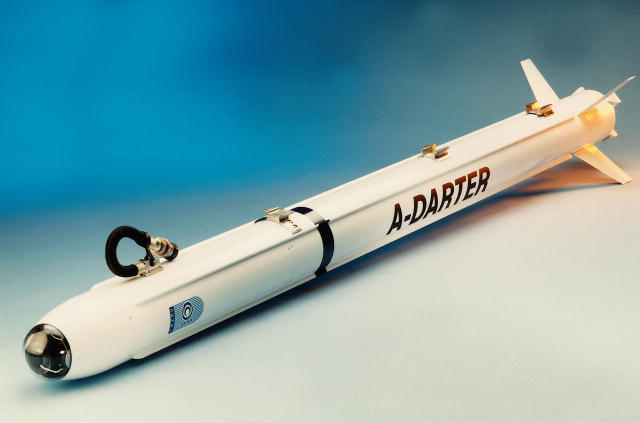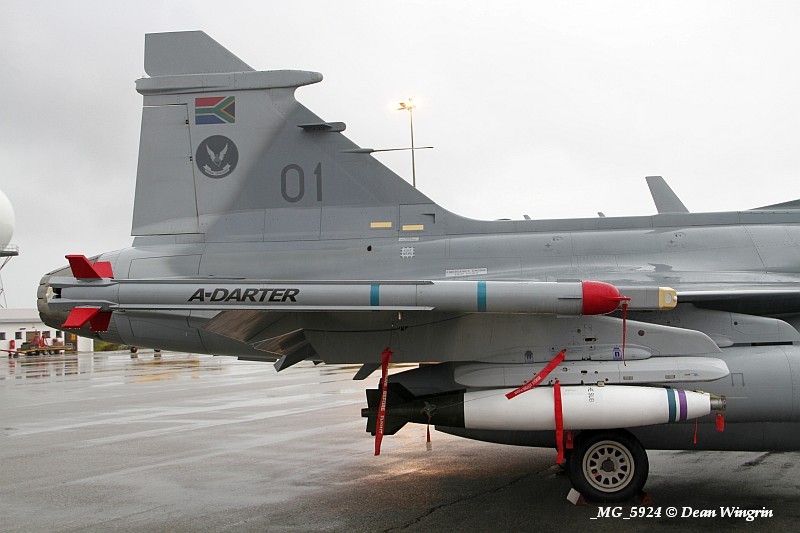A-Darter, also known as V3E Agile Darter, is a fifth-generation short range, a modern short-range infrared homing ("heat seeking") air-to-air missile, featuring countermeasures resistance with a 180-degree look angle and 120-degrees per second track rate,under development by South Africa’s Denel Dynamics (formerly Kentron) and Brazil’s Mectron, Avibras and Opto Eletrônica.It will equip South African Air Force’s Saab JAS 39 Gripen C/D and BAe Hawk 120; Brazilian Air Force’s A-1M AMX, Northrop F-5BR and Gripen E/F.It is expected to be in production before the end of 2015.
The missile system completed several successful test launches in January 2012. It entered the final qualification phase in March 2012 and is expected to be ready for production by 2013.
The missile will enter service with the South African Air Force (SAAF) and Brazilian Air Force (FAB) in 2014.
Development
Development of the A-Darter started in 1995,however it suffered from inadequate funding and changes to the SAAF’s requirements.Mectron, Avibras and Atech joined the program in 2006 after a three-year negotiation process with US$52 million invested by the Brazilian Government in the project, estimated to be worth US$130 million.In that same year, Denel announced that it would use the latest solid-state inertial measurement unit, the SiIMU02 from BAE Systems, for mid course range guidance.The Brazilian company Opto Eletrônica has partnered with Denel Dynamics in the development of the missile imaging infrared seeker for thermal guidance.
High explosive (HE) warhead and systems of the A-Darter SRAAM
The A-Darter is 2.98m (9.78ft) long and 0.16m (0.52ft) in diameter. It has four fixed delta control fins at the rear and two strakes along the sides. The missile weighs 90kg.
It carries a high explosive (HE) warhead and has a range of ten kilometres. It is powered by a solid propulsion system. The missile has a track rate of 120°/s and a seeker angle of 180° for countermeasure resistance. It also features lock-on after launch and memory tracking for higher range intercepts, and is compatible with Sidewinder stations.
The tail-controlled AAM is powered by a boost-sustain rocket motor and uses thrust vector flight control. Its wingless airframe and low drag enable the A-Darter to have a higher range than the traditional SRAAMs. The missile system is designed with a highly agile airframe for close combat in electronic countermeasures (ECM) environments.
It is guided by two-colour thermal imaging infrared homing with laser fuse. It features a multimode electronic counter countermeasures (ECCM) suite for higher view angles.
The SiIMU02, an inertial measurement unit (IMU) from Atlantic Inertial Systems (formerly BAE Systems), provides the mid-course guidance for the missile. Solid-state technology of the IMU provides accurate measurement of angular rate and acceleration range of up to ±9,000°/s, ±500°/s and ±500°/s in R, P and Y-axes respectively. It has a linear acceleration range of up to ±30g.
When integrated, the missile can interface with the aircraft using LAU-7 type launcher mechanical rails and MIL-STD-1760 / 1553 avionics bus system. It can be designated to a target using autonomous scan feature of the missile, helmet sight or aircraft's radar.
Ground seeker tests were concluded in January 2010,while trajectory guidance and agility flight tests were performed in February 2010.Prototypes were sent to Saab AB in order to begin the integration of the missile to the Saab JAS 39 Gripen. Captive flight trials were concluded in March 2010.The first successful in-flight launch from a Gripen fighter took place on 17 June 2010.
In March 2012, Denel Dynamics disclosed that the missile, which was to be ready for production by end of 2013, entered the qualification phase. Several testing firings at Denel’s Overberg Test Range were carried out from a Gripen in January 2012. Final testing included the use of high-speed target drones to simulate an aircraft by towing infrared targets at high speed.
In December 2012, the Brazilian air force commissioned Denel to build a factory in São José dos Campos, close to Mectron, Avibras and Opto Eletrônica.
In February 2015, Denel Dynamics signed an agreement with Marotta Controls for supply of the latter's MPACT pure air compression technology to cool the A-Darter's infrared seeker.
High explosive (HE) warhead and systems of the A-Darter SRAAM
The A-Darter is 2.98m (9.78ft) long and 0.16m (0.52ft) in diameter. It has four fixed delta control fins at the rear and two strakes along the sides. The missile weighs 90kg.
It carries a high explosive (HE) warhead and has a range of ten kilometres. It is powered by a solid propulsion system. The missile has a track rate of 120°/s and a seeker angle of 180° for countermeasure resistance. It also features lock-on after launch and memory tracking for higher range intercepts, and is compatible with Sidewinder stations.
The tail-controlled AAM is powered by a boost-sustain rocket motor and uses thrust vector flight control. Its wingless airframe and low drag enable the A-Darter to have a higher range than the traditional SRAAMs. The missile system is designed with a highly agile airframe for close combat in electronic countermeasures (ECM) environments.
It is guided by two-colour thermal imaging infrared homing with laser fuse. It features a multimode electronic counter countermeasures (ECCM) suite for higher view angles.
The SiIMU02, an inertial measurement unit (IMU) from Atlantic Inertial Systems (formerly BAE Systems), provides the mid-course guidance for the missile. Solid-state technology of the IMU provides accurate measurement of angular rate and acceleration range of up to ±9,000°/s, ±500°/s and ±500°/s in R, P and Y-axes respectively. It has a linear acceleration range of up to ±30g.
When integrated, the missile can interface with the aircraft using LAU-7 type launcher mechanical rails and MIL-STD-1760 / 1553 avionics bus system. It can be designated to a target using autonomous scan feature of the missile, helmet sight or aircraft's radar.
Design
The missile seeker can be slaved to the Helmet Mounted Display (HMD),allowing the pilot to track a target beyond the aircraft's radar scan envelope using the missile's high off-boresight capability, achieved by the pilot turning his head towards the target to lock-on,better known as “look and shoot”. The missile can then be launched and can immediately pull extreme g-force to reverse its course in order to engage a target behind the aircraft, sometimes called an "over-the-shoulder".Engage modes include Lock-On After Launch (LOAL) capability to engage targets outside its seeker's acquisition range, and Lock-On Before Launch (LOBL) capability where the target is identified and designated before launch.The two colour thermal imaging technology and a laser proximity fuse fitted on the missile provide multiple Electronic counter-countermeasures (ECCM) techniques with targeting algorithms including advanced spatial filtering techniques and velocity profiling.
The A-Darter has four major sections: guidance section, warhead, control, and rocket motor. It uses a streamlined design with low aerodynamic drag in a wingless airframe, ensuring ranges beyond those of traditional short-range missiles. It is fitted with a thrust vectoring control (TVC) system to provide agility up to 100 times the force of gravity (100G).
The absence of aluminium powder from the motor propellent inhibits production of a smoke trail, which means no visual warning for enemy aircraft. According to SAAF fighter pilots involved within the project, the A-Darter it is better than the IRIS-T in some respects.
Variations of the SAAF and FAB's V3E Agile Darter air-to-air missile
The proposed future versions of the A-Darter include the A-Darter Mk 2, A-Darter Mk 3, A-Darter Light, A-Darter anti-shipping missile (ASM) and A-Darter Extended Range.
Denel Dynamics is also developing a new radar-guided, beyond-visual-range AAM (BVRAAM) missile called B-Darter. A surface-to-air missile (SAM) version of the A-Darter AAM is expected to be developed for the Brazilian Army. The SAM version of A-Darter will, however, need a launcher system and additional booster.


